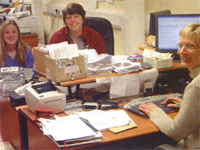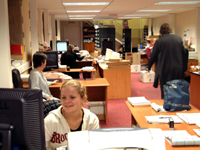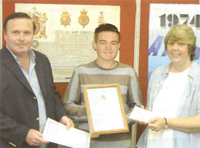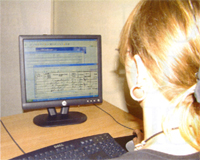Helping to check census transcriptions makes life a lot easier for genealogists everywhere - and there can be great perks, too!
The rapid expansion of the internet has been a boon for those trying to research their family trees, with every month seeing the arrival of more databases that help transform our understanding of our ancestors' lives. For many people, though, the internet is now becoming as much about giving as it has been about receiving, with more and more websites enabling the home user to contribute towards the online availability of genealogical data.
 |
 |
ON TASK - Staff at S&N Genealogy's main office in Wiltshire, are kept busy
working on the company's websites and products. |
UK Indexer (www.ukindexer.co.uk) is one such project that uses volunteers to corroborate the census indexes and transcripts that are produced by the family-run business S&N Genealogy and published on its website TheGenealogist (www.thegenealogist.co.uk). The idea started several years ago when Nigel Bayley and his wife, Sue, went into business to make the censuses of England and Wales available on CD-ROM and DVD, initially using a disc burner "the size of a small suitcase" as Nigel recalls.
While these products greatly helped the amateur historian working from home, the images weren't indexed in any way other than street name, making it difficult for users to find a particular individual on a disc if they didn't know where he or she lived.
The couple therefore took the decision in 1999 to set up an online project whereby volunteers could help create indexes for the census images that would list names and addresses of all thos enumerated. In return for the time spent helping out, volunteers would be rewarded with vouchers to be redeemed against S&N's catalogue of genealogical materials.
Slow Progress
The initial enthusiasm of the team of volunteers and the rapid success of the project took Nigel completely by suprise. "I attended a family history fair in YOrkshire and one gentleman approached me with a couple of hundred pounds of vouchers to buy our products," he says. "He had become so involved that he was actually using our project to fund his family history hobby - it was quite extraordinary!"
Although many volunteers were taking part in the project, it became clear that the indexing was moving forward at an agonisingly slow pace, a situation that had been experienced a few years before by the Church of the Latter-day Saints when it had indexed the 1881 Census - an exercise that took ten years.
|
The enthusiasm of the volunteers and the rapid success of the project was a complete suprise.
|
With the sheer amount of census material available, it took Nigel and Sue's volunteers two and a half years just to reach the halfway stage with the 1891 London Census, while many other parts of the country had yet to be started. With the ambition being to index the complete 1841-1901 census for the whole of England and Wales, a different tack was called for, so in early 2004 the work was outsourced to a company in India to speed up the process.
A major benefit of this new plan was that it presented an opputunity to greatly increase the scope of the project - not only could the images be indexed more quickly, they could also be fully transcribed to provide all the details within each census entry, including birthplaces, occupations, ages and more.
 |
PRAISE - Nigel and Sue present an award
to a young genealogist. |
But the role of the volunteers was far from over, and Nigel was keen to keep his community of helpers actively involved in the project. "We thought long and hard about the plan to outsource the work to India, but one of the benefits of the work previously undertaken by our volunteers was that we could use what had already been indexed by them to check the quality of what was now coming back from our transcribers," he explains. "Many of the fields were often illegible on the original census returns, and in some cases the unfamiliarity of certain British surnames and place names could lead to errors being made. Absolutely everything needed to be checked and double checked, and as we knew how popular our scheme had been, we asked our volunteers to continue working for us by checking the indexes as they came in. In return we would continue to offer them the same benefits as before."
Arrival of UK Indexer
|
Volunteers work on as much or as little as they like. The more they do, the greater the rewards.
|
At first, volunteers continued to check the indexes through TheGenealogist website, but when this became too unwieldly a new dedicated site was set up - www.ukindexer.co.uk. The new website went live in 2005, making it even easier for people to participate. In the original indexing project, volunteers had been asked to check whole pieces from the census, often at a considerable number of pages per piece.
Realising that this could become quite a burden for many, the project has been restructured to allow volunteers to choose to work on as little or as much as they like. Obviously, the more that can be done, the greater the rewards, which now not only include vouchers for S&N's products, but also the chance to obtain online credits.
 |
| CHECKING IN - Volunteers use a range of tools to help at every stage. |
These can be used by volunteers to help with their own family history research on www.thegenealogist.co.uk, which gives access to indexes for births, marriages, deaths, census returns, wills, parish registers, and much more.
For volunteers such as 65-year-old retired laboratory worker Vernon Hill, working on the project is both a challenge and a reward. "I started as a UK Indexer volunteer about two years ago, and have spent quite some time correcting the index for the 1851 Cornwall census, where the writing and unusual Cornish surnames obviously caused the transcribers a few headaches!" he says.
For his efforts, Vernon has been rewarded with credits that have allowed him to use TheGenealogist website to further his own research, which goes back to the mid 19th Century. "I spend approximately an hour or two each night checking an index, so I guess you could say it can be quite obsessive. One of the benefits of working on the unusual Cornish entries is that there are more corrections to be made to the transcripts, and with more corrections, you earn more credits. So I've certainly gained a great deal from the project, and at the same time I've had a lot of fun working on it."
Using the Site
Taking part in the project could not be easier for volunteers. After subscribing to the UK Indexer website (www.ukindexer.co.uk), you are asked to log in and are then taken to an introduction page that gives you access to the tools necessary for the job. Once you get into the site, you're advised to visit the project's help pages to receive the basic pointers for getting underway, after which you'll then be asked to complete a simple assessment. When you take the test you'll see a split-screen image: one half contains the transcripts of a particular census page, the other the original census image. The specific entries that need to be examined are highlighted, and once you have made the necessary changes you move on to the next, for a total of ten pages.
| |
Meet the Volunteers:
BONNIE BEAN |
 Living near Brisbane, Australia, Bonnie Bean is one of the longest serving volunteers for UK Indexer, having been involved for seven years. "I must admit that I'm very choosy - everything must be indexed as written," she says. "If I'm not sure of the writing or the word I'll keep looking until I find it, whether it's in a later census or birth record. It becomes a passion after a while, and the challenge comes in making sure that I've got it right." Living near Brisbane, Australia, Bonnie Bean is one of the longest serving volunteers for UK Indexer, having been involved for seven years. "I must admit that I'm very choosy - everything must be indexed as written," she says. "If I'm not sure of the writing or the word I'll keep looking until I find it, whether it's in a later census or birth record. It becomes a passion after a while, and the challenge comes in making sure that I've got it right."
Bonnie tries to do about two or three hours indexing work a day, but what does she get in return? "The enjoyment comes in finding odd families - where the hubby is much older than the wife and the children keep coming, or the opposite, where the wife is older than the hubby. Sometimes you even get to find the housekeeper having the house-owner's children!" |
On passing this assessment, you can then move on to the main project itself, but should you fail you can easily redo the test having another chance to read the intial pointers to help you understand any mistakes you might have made.
Helping you in your task, the UK Indexer site has a range of extremely useful online tools which you can consult at any stage during the process.
There's a step-by-step user guide for the intial assessment, which can be printed out so that you can consult it as you work. In addition, there are help and 'frequently asked questions' sections that can be consulted whenever a problem arises. ALso useful is a dictionary to help you out with possible surname variants, noting how often those variations appear within the whole census.
Some entries, with the best will in the worls, will always defy conclusive identification, and in these instances the project team will canvass several opinions on a particular problem before deciding on the most likely correct transcription solution.
The Future
Licensing issues have unfortunately held up Nigel's hopes of indexing the various Scottish censuses and birth, marriage and death records, but there's still plenty for UK Indexer volunteers to concentrate on. There are many exciting new developments lined up for TheGenealogist website in the forseeable future.
With the full indexes for the births, marriages and deaths of England and Wales from 1837 already available, the next big project will be to start indexing the earlier Church of England parish registers in conjunction with many of the country's local county archives. And with much of the census project still to be worked on, there's never been a better time to lend a hand and get something out of it for your own research!
| |
STEP-BY-STEP: Getting Started on UKindexer.co.uk |
|
 |
[1] Having successfully registered with the site and logged in, start by reading the 'Help for first time users' link on the left-hand side of the screen, which will give you an overview of the assessment test you'll be taking. Once you've read it through carefully, return to the home page and click on the button marked Review Tool. |
[2] Two half-screen sized windows should now appear, the top showing the transcription, the bottom the original image. (If you can only see the top, deactivate your pop-up blocker). The line with the white boxes highlighted is the one with the suspected transcription error, in this case for a George Edgson, aged 46, listed as the head of the house. |
[3] On the original census viewer, look for George Edgson's entry. You can see from reading this that he has been mistakenly listed as being 46 years of age in the transcript, when he's actually only 26. Type in the correct age on the top screen and then click the Update box. Finally, move on by clicking the Next button (the arrow pointing right). |
|
 |
[4] The second entry now comes up for you to check, with both screens being refreshed at the same time. As before, find any errors in the transcription. In this case, 38-year-old Stafford B Somerville has been mistakenly transcribed as 338-year-old Sattford B Sommerville! Again, correct the mistakes before clicking Update and moving on. |
[5] If you come across a surname that you're unsure about, try using the dictionary link which you can find on the top screen. In this example, a family surname is recorded as both 'Tulk' and 'Fulk'. The dictionary can find no entry for 'Fulk', but notes the name 'Tulk' as having been recorded on 77 other entries. Clearly 'Tulk' is more likely to be the correct version. |
[6] Once you've uploaded your last entry, a summary screen will appear highlighting the changes you've made. If you're happy with these, click 'Checking done, upload piece'. After confirming the instruction, return to the home page. The Review Tool will now be called the Page Tool and you're ready to start checking transcripts for real! |
|
Contact
The Genealogist - www.TheGenealogist.co.uk
S&N Genealogy - www.SandN.net
UK Inderxer - www.UKindexer.co.uk |